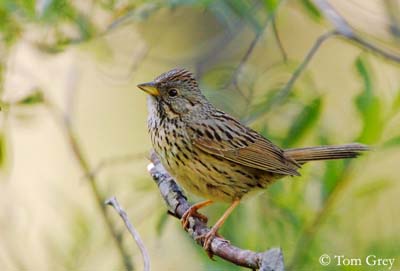
Lincoln’s Sparrow
Melospiza lincolnii
Passeriforme Order – Passerellidae Family
BIOMETRICS:
Length: 13-15 cm
Wingspan: 18-22 cm
Weight: 17-19 g
LONGEVITY: Up to 7 years
DESCRIPTION:
Lincoln’s Sparrow is a small songbird, and both sexes are similar.
Adult has mottled brown upperparts; back is light brown with dark brown striping. We can see buffy wash and fine streaks on breast and sides. Belly is whitish. A broad grey eyebrow contrasts with whitish chin and eye ring.
Lincoln’s Sparrow has conical, strong bill. Upper mandible is dark, and lower is pale reddish brown. Legs and feet are reddish brown. Tail is thin and rounded.
Ang: Lincoln’s Sparrow
All : Lincoln – Ammer
Esp : Sabanero de Lincoln
Ital : Passero de Lincoln
Nd : Lincoln – gors
Sd : Lincolnsparv
Photos de Tom Grey
Son site : Tom Grey's Bird Pictures
Texte de Nicole Bouglouan
Sources :
FIELD GUIDE TO THE BIRDS OF NORTH AMERICA by National Geographic Society - National Geographic Society - ISBN: 0792274512
A GUIDE TO THE BIRDS OF MEXICO AND NORTHERN CENTRAL AMERICA by Steve N. G. Howell, Sophie Webb - Oxford University Press - ISBN: 0198540124
BIRDS OF THE GREAT BASIN – by Fred A. Ryser - Univ of Nevada Pr -ISBN: 0874170796
All About Birds (Cornell Lab of Ornithology)
Bird Web (Seattle Audubon Society)
What Bird-The ultimate Bird Guide (Mitchell Waite)
Wikipedia (Wikipedia, The Free Encyclopedia)

Juvenile is similar to adults, but with buffy eyebrow.
Nestlings have blackish grey down on head, back, wings and thighs.
VOICE: SOUNDS BY XENO-CANTO
Lincoln’s Sparrow has two call notes: a flat repeated “tschup” and a sharp, buzzy “zeee” in flight. It utters a rich and loud song, a rapid bubbling trill.
HABITAT:
Lincoln’s Sparrow breeds in bogs, wet meadows and riparian thickets.
It winters in brushy areas, thickets, hedgerows, forest edges, clearings and scrubby areas.
RANGE:
Lincoln’s Sparrow breeds from Alaska and Canada, to northern US, and in mountainous west to southern California, Arizona and New Mexico.
It winters from southern US to Central America, and also along Pacific Coast.
BEHAVIOUR:
Lincoln’s Sparrow gleans for food from the ground, insects and seeds.
Its courtship display is not known very well, but male sings to attract female, and sings much less when incubation begins.
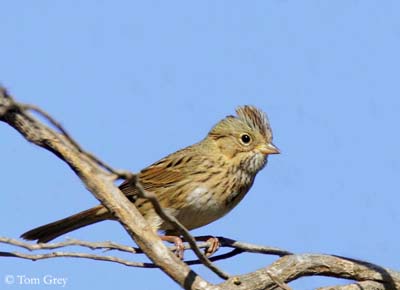
Lincoln’s Sparrow is a shy bird. When alarmed, it raises its crown feathers. They are territorial birds, threatening intruders with wing-flapping and hoarse calling, singing, and it may attack using its claws.
If bird is disturbed while incubating, it escapes by running along the ground. If nestlings are in the nest, adult performs a display, feigning a broken wing.
FLIGHT:
Lincoln’s Sparrow performs active flight. It alternates several rapid wing beats with wings pulled to the body sides.
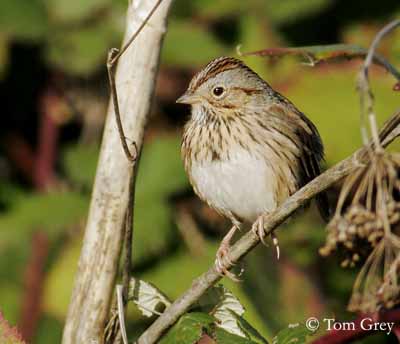
REPRODUCTION:
Lincoln’s Sparrow is monogamous. Female builds the nest on or near the ground, in shallow depression, in moss or grass tussocks. It is made with grasses, and lined with finer grass and hair. Nest is an open cup well concealed under vegetation.
Female lays 4 to 5 pale green eggs with reddish spots. Incubation lasts about 12 to 14 days, by female. Chicks hatch altricial. They are fed by both parents during 9 to 12 days, until they fledge. Parents continue to tend and feed them for another 2 to 3 weeks.
This species produces two broods per season.
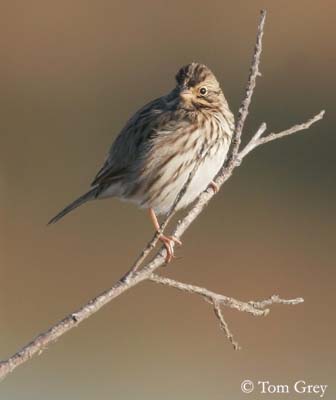
DIET:
Lincoln’s Sparrow feeds mainly on insects, but also spiders and millipedes. It also consumes seeds of grasses in winter. Young are entirely fed on insects.
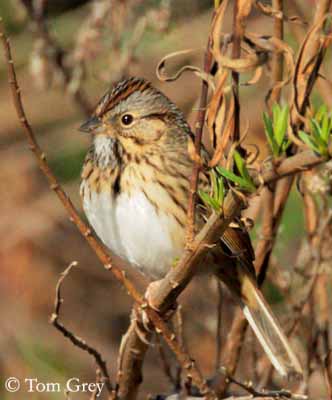
PROTECTION / THREATS / STATUS:
Lincoln’s Sparrow is threatened by herbicides on forest clear cuts and migratory collisions with TV towers.
This species has some predators such as weasels, chipmunks, jays and small rodents. However, most populations are slightly increasing.
This bird was named by Audubon after his friend Thomas Lincoln.